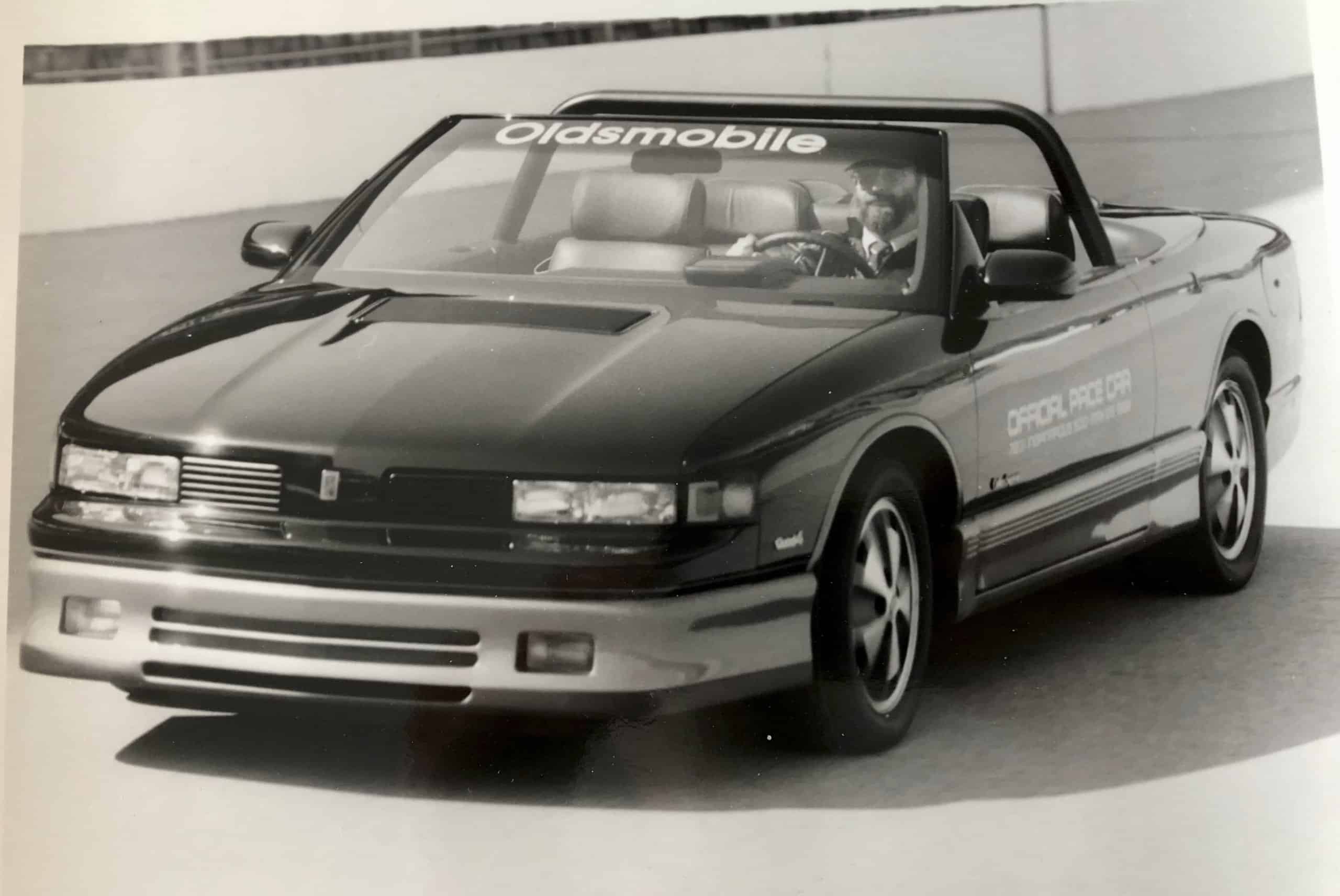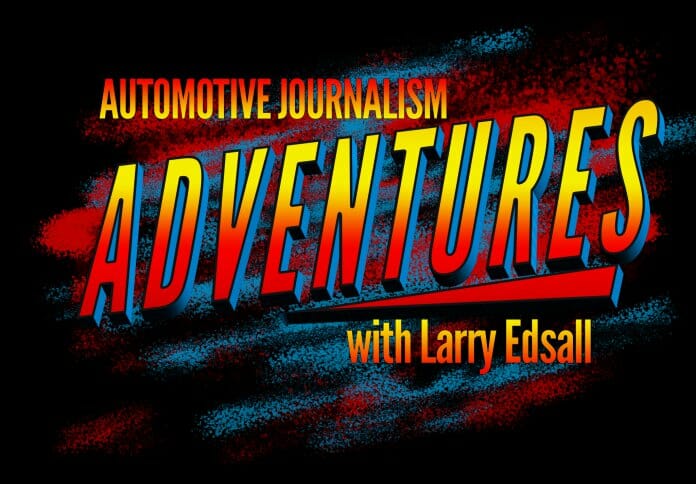OK, so maybe the word “starred” is overstating the case, but if you lived in the Indianapolis area back in 1988, you might remember watching the local Oldsmobile dealers’ television commercials about the new Oldsmobile Cutlass Supreme being the pace car for the 500-mile race.
You might have recognized the car in that commercial as one of two prepared for possible on-track use during the month of May. What you likely didn’t recognize was the person driving the car. It was me.

Back in April of 1988, I was just a few months into my new job as motorsports editor at AutoWeek magazine and had just been given my first cover-story assignment.
Well, actually, it was my second cover assignment. The first one involved sitting silhouetted in a make-believe jail cell and being photographed as a stand-in for racing driver John Paul Sr., who at the time was serving a 25-year sentence in federal prison.
This time I was sent to Indianapolis to do a magazine cover story about driving the Cutlass Supreme that would be the Indy 500 pace car. It turned out that two such cars were prepared for such duty. Both were convertibles and each was powered by a turbocharged Quad 4 engine.
Though the race cars following the Olds would be capable to speeds of 200 mph, the pace cars, I soon discovered, were limited in the name of everyone’s safety to 109 mph.
“Aw, the frustration of it,” I wrote. “To finally make enough laps to have an idea of where the groove is. To come out of the second turn with the engine begging for more right foot, watching the speedometer climb through the count — 104, 105, 106, 107, 108, 10chug, 10chug, knowing that nothing you do behind the wheel can overcome what engineers have done under the hood.”
Basically, for my drive, I had the car and the track for half a day. It started with me riding along with Don Bailey, a former stock car racer and the long-time Indianapolis Motor Speedway staffer who oversaw all things pace car related. Although U.S. Air Force Brig. Gen. (Retired) Chuck Yaeger would drive the ceremonial pace laps to get the 500 started later that month, as usual, Bailey would be taking the wheel during caution periods during the race.
Knowing the man who first broke the sound barrier also would undergo Bailey’s driver-training program made me feel better about starting in the passenger’s seat. Bailey drove, and then I drove, and once he was satisfied that I wasn’t going to damage his pace car, I had the car and the track to myself.
Oh, with one proviso: If I was going to exceed 50 mph, I would have to wear a helmet. It was, and I did, but primarily to hide my frustration of having an open straightaway in front of me but also having a 109 limit on how far I could push the speedometer.
In addition to a 2½-page story about driving the pace car, I wrote a sidebar about Olds’ history of supplying Indy pace cars and another on Cars & Concepts, the company from suburban Detroit that prepared the Cutlasses for their Indy duties.
Turned out that since the new GM10 cars weren’t yet in production, the pair of 1988 pace cars were actually pre-production coupe prototypes more or less worn out after being used as engineering development vehicles. Cars & Concepts removed the roof structures, reinforced the chassis, and then re-assembled, equipped, prepared and tested before turning over to the Speedway staff.
Among the features on the pace cars were heads-up display, FE3 suspension components, anti-lock brakes and the special tuning of the engines. A few months earlier, A.J. Foyt had set a closed-course speed record of 257.123 mph in an aerodynamically designed Olds Aerotech powered by a Quad Four.
Even though the pace car engine was speed-limited, it still pumped out 250 horsepower (100 more than in the standard Cutlass Calais) and had 250 pound-feet of torque.
Olds engineer Art Frelund rode along with me for a couple of laps to talk about the engine, and at one point he suggested I stop after coming out of Turn Two and do a simulated drag racing down the backstretch. I wrote about how quickly the numbers flashed on the heads-up display until we had to slow to enter Turn Three.

About the time I thought my time in the car was done, I was asked if I’d be willing to drive some more, but this time sans helmet. The local Olds dealers group needed to shoot its commercial and needed someone to drive the car and since I’d been doing quite a few laps, would I keep going, albeit at 45 mph while following behind a flatbed truck carrying still and video photographers and crew.
I figured seat time was seat time, and besides, how often do you get to drive laps at Indy?
Somewhere in a storage box, I have a VHS tape (remember those?) that Oldsmobile sent me later showing the various post-production versions of the commercial. There I was, driving around the Brickyard in the pace car.
I’d be tempted to go searching for that tape, but it seems pointless. It’s been years since I’ve had a VCR (remember those?) that could play such an ancient cassette-recording device.






As always, a great read!! When’s the next chapter?
Too cool!!! Love the story…find the tape and have it copied. Can it be done ? I don’t know but I would try. I enjoy your stories.
Thank you
Those VHS tapes can be converted to DVD You should do it & post a video. Oh by the way, Always great material & I enjoy reading your articles.
@ James , my very thoughts . Good reading !
I have several “ancient” VCRs and watch my tapes regularly no problem….I enjoy that technology. I dont find it “ancient” at all….
Ooh- I was there. No, I didn’t know who you were. Grew up in Indy, at the time was an adult ex-military vet living in Eagledale, a neighborhood of Indy a 5min stroll from the north entrance gate, where you could hear every stroke of every engine running the track or being tested in Gasoline Alley.
For the record, I’d bet I have more laps at the Brickyard; I was a drummer in Harvey Gill’s Indianapolis Boy Scout Band, and we did the pre-race parade with the Purdue University marching band every year. Did this from 11 ’til 17, along with the promotions, tours, practice, and offered rides. Back then, being a Scout meant something, and the Band was famous in the US and Canada.
Too bad about the limiter. Imagine some of the earlier pace cars… remember the Dan Young Chevrolet supplied ’69 Camaro SS/RS white/orange striped pacers? Zoom-zoom, indeed.
☮️
oldsmobile was also the pace car in 1949.
I’m slowly but surely going through the boxes in my garage. When I find the VHS tape, I’ll see about digitizing it and sharing on the Journal.
That would be great! I can’t wait to see it!
Great read and also enjoyed the readers’ comments. I began working for an Oldsmobile and Cadillac dealership at age 13, in Marquette, Michigan, 1954. My dad always had Olds ’98’s during the 1950’s…a new one every two years. Put a lot of mileage on them–I finally could drive his after getting my license at age 16..But got an early start at 13 at the Public Service Garage as a grease monkey and was able to move the used cars around the lot…so drove standards and automatics at an early age. Definitely find that old VHS tape. (I did share this on Facebook with folks up in Marquette County in the Upper Peninsula of Michigan..)